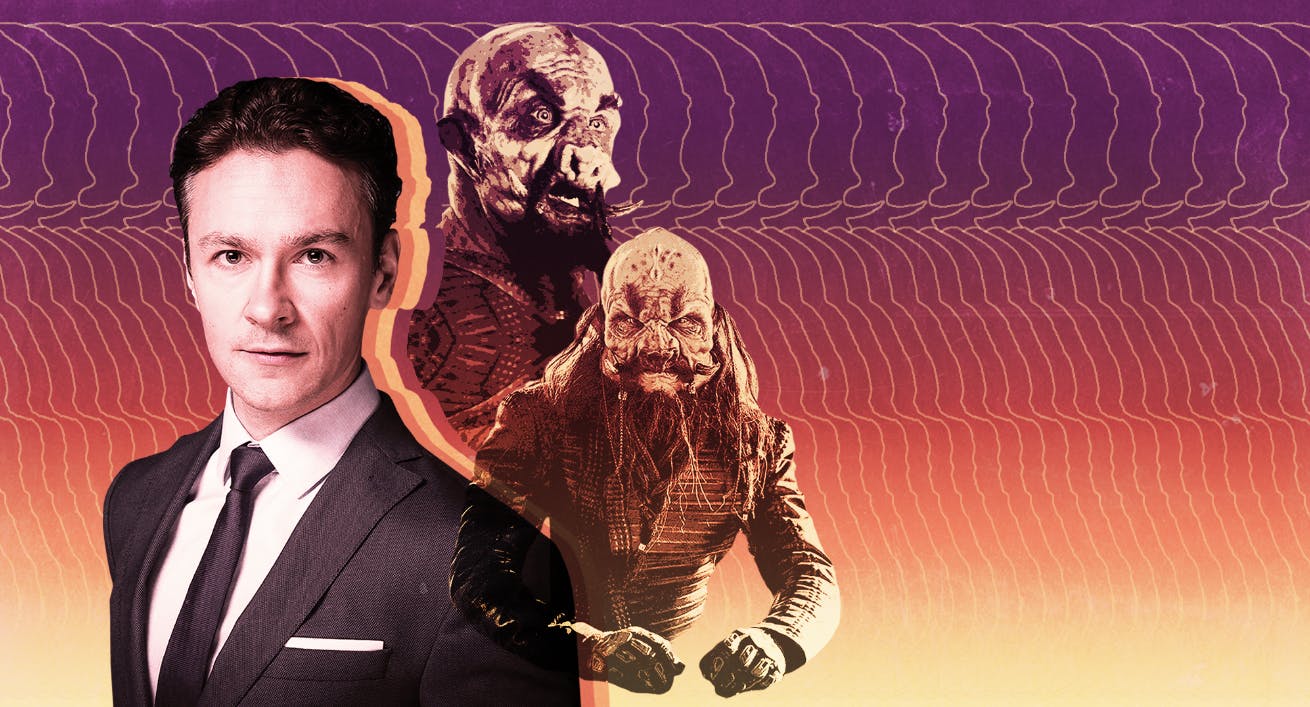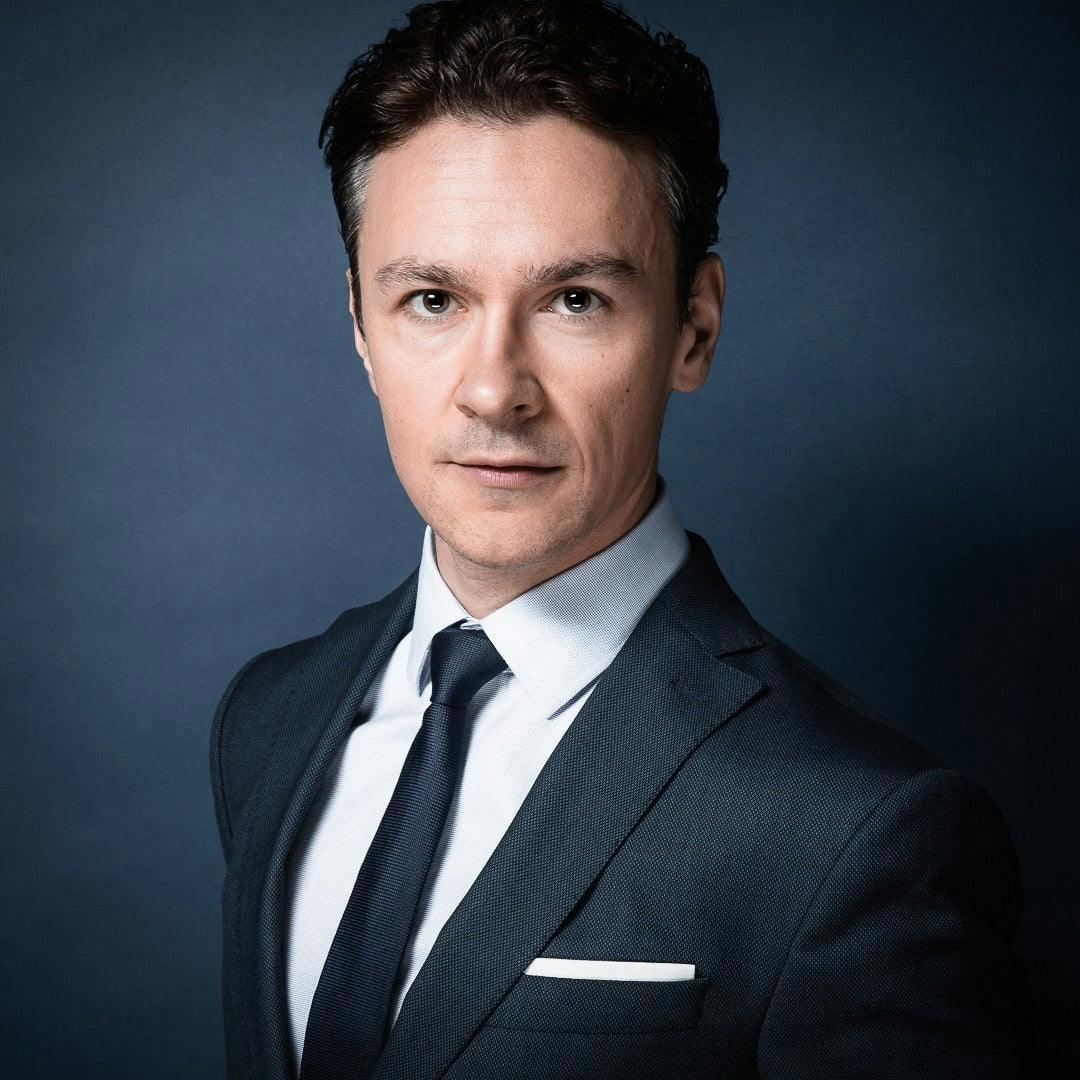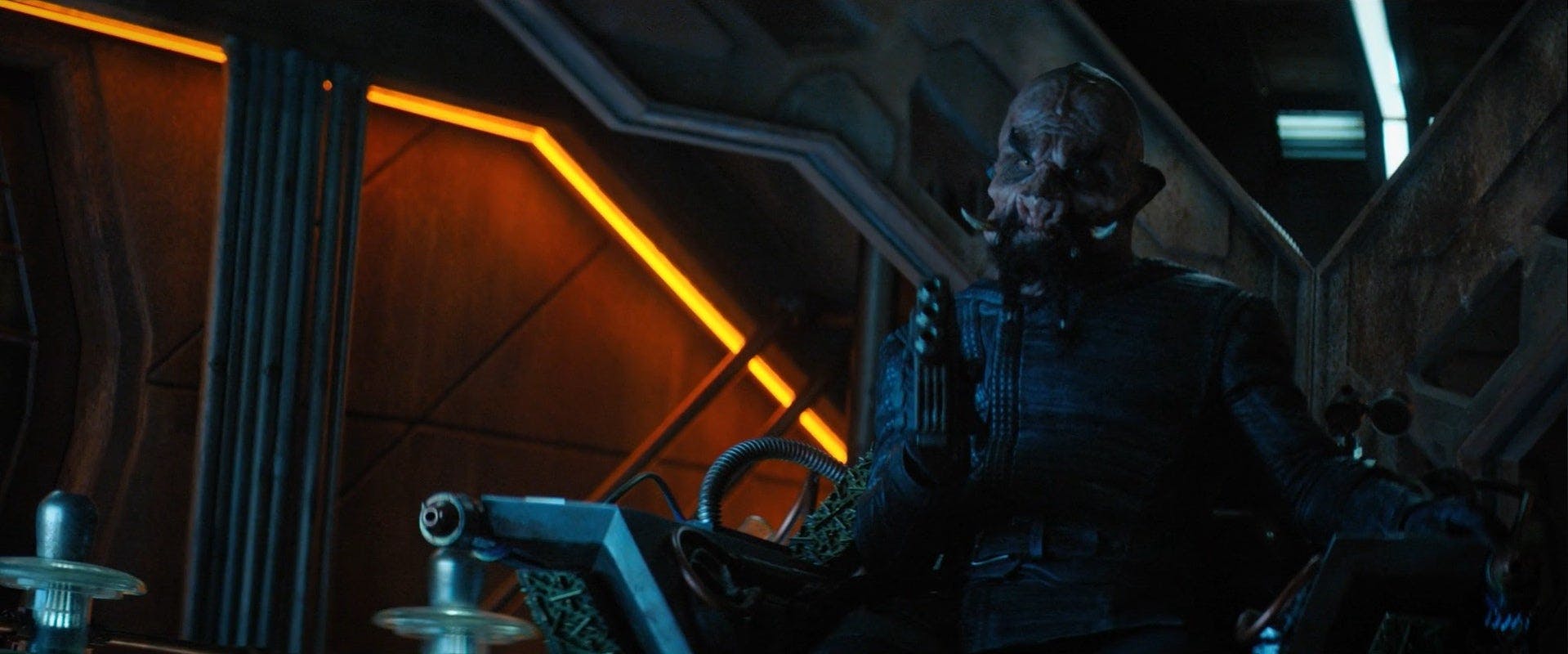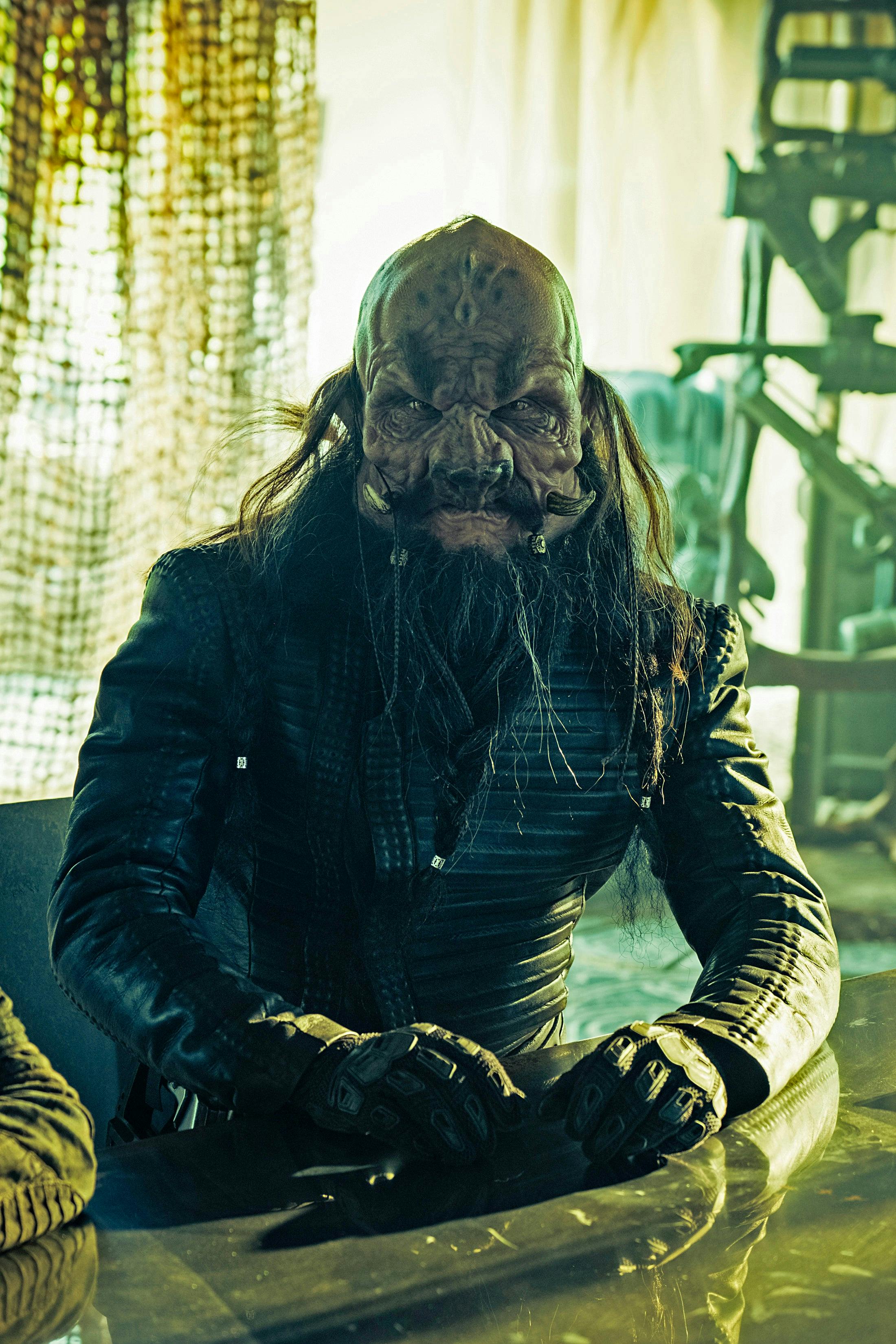Published Jul 22, 2020
Talking Tellarites with Harry Judge
The alien actor talks to StarTrek.com about prosthetics, Short Treks, and what it's like to take on multiple roles.

StarTrek.com
After being introduced in Star Trek: The Original Series’s “Journey to Babel,” the Tellarite species was not truly explored in an in-depth fashion until Star Trek: Enterprise. Star Trek: Discovery followed that trend, and the series seems to have found their resident Tellarite in Canadian actor Harry Judge. Originally appearing as Mirror Gorch in Discovery’s “The Wolf Inside,” Judge went on to portray the Prime Universe’s Admiral Gorch in “The War Without, The War Within” and “Will You Take My Hand?,” an unnamed Tellarite admiral from Section 31 in “If Memory Serves,” and the bounty hunter Tevrin Krit who pursued Harry Mudd in the Star Trek: Short Treks episode “The Escape Artist.”
#Trekformations: Creating a Tellarite
StarTrek.com caught up with Judge to discuss his bevy of Tellarite roles, being directed by Rainn Wilson, his first visit to the official Star Trek convention in Las Vegas, and much more.
StarTrek.com: Thanks for speaking with us, Harry. How familiar were you with Star Trek and the Tellarite species before you auditioned for Star Trek: Discovery?
Harry Judge: I was very familiar with Star Trek. I grew up watching reruns of The Original Series and live episodes of The Next Generation. I had also watched Deep Space Nine, but no Voyager or Enterprise prior to my audition. I had watched all of the movies, though. I felt like my understanding of the show served my audition, because I knew what the tone of Star Trek was. Star Trek’s tone is very different from Star Wars, for example. I remember hearing a story from someone I know who also auditioned, and it sounded as if what he had done had more of a Star Wars tone. Maybe a little more animated and intense.

StarTrek.com
I auditioned with what I perceived as the feeling of the Star Trek universe in mind. Would I call myself a Trekkie? No. I didn’t have a uniform or dress up as a kid, but it was still a big part of my experience when I was growing up. The characters lived in me, I knew them all intimately. I remember watching “The Best of Both Worlds” cliffhanger live and just saying, “What?! Locutus of Borg? What?!” That was a fundamental part of my upbringing.
As for the Tellarites, I wasn’t familiar with them at all. I didn’t realize I was auditioning for a pre-existing species, I thought it was a new race. The script said “Tellarite,” but I didn’t clue in to the fact that they had already been established in canon. I didn’t do Tellarite-specific research until after I’d been cast [laughs]. I tailored my audition, subtly adjusting my performance as though I was wearing a prosthetic.
I don’t know if this was something that would have been consciously perceived by casting or the producers, but it was very intentional on my part. I’d done mask work before, and there’s another layer of energetic and physical communication that has to happen in order to truly express yourself. I was transmitting that in my audition with subtle shifts in the movement of my neck and head.
What was your initial reaction when you saw the Tellarite prosthetics that you would be wearing?
HJ: Stunned! Just like, “Wow!” I was absolutely floored, it was fantastic. By that point, I had done my Tellarite research and had certain expectations about the porcine features. I guess I was in the trailer and I initially saw it a little bit on the model. I just thought it was so fantastically bestial. This essence felt so much different than all the Tellarites we had seen before. This felt much more animalistic. As the first Tellarite established in Discovery, it dawned on me that it would be my responsibility to carry that quality and expression of being.
Which Tellarite character did you try out for first? Did you have a feeling that it might lead to multiple appearances?
HJ: The character I auditioned for was “Tellarite Male.” There was an awareness that it’d be for a few episodes. Even though I was booked for three, I could always have been written out. I was just crossing my fingers that I would have a character name. For a while, I was just “Rebel Tellarite,” until it came close to the last draft of the script. The audition scene was a generic one that was written for the audition, it wasn’t from an episode. I didn’t have any sense of a specific character that I was working towards. The audition involved conflict between a Tellarite and an Andorian, so I really leaned into playing that.
It then became clear that the first Gorch was going to be in the Mirror Universe, and then the second episode introduced the Prime Admiral Gorch. As far as the third Tellarite, the unnamed one from Discovery’s second season, there was no audition for that. However, for Tevrin Krit in “The Escape Artist,” they brought me back onto set, put me into prosthetics, and had me audition for Doug Aarniokoski and Ted Miller. I was in jeans, a t-shirt, and my Gorch prosthetic just “Tellariting” my ass off in Pinewood Studios (laughs).

StarTrek.com
I auditioned for them with an iPhone to try to show them that I could make this prosthetic work. I think there might have even been a question as to which alien they were going to use for that Short Trek. I had the sense that I was fighting for that role, that I had to prove that I could pull it off. It was intense, I’ll admit that I walked out of there feeling as if I had failed. Even though I think people thought I was good to work with and they liked having me on set. The demands were going to be greater here, and I had to go in and show that I could really make the prosthetic come alive. The Tellarite prosthetic is so thick, and so depth-challenging to work with. It’s some of the hardest work I’ve ever done.
Your Short Treks episode “The Escape Artist” premiered prior to Discovery’s second season. What was it like collaborating with Rainn Wilson in his roles as both the episode’s lead and its director?
HJ: Working with Rainn was a wonderful experience. He was a total pleasure, and I felt appreciated and respected by him. Once he realized that I was a trained theater actor and knew that I’d be able to rapidly respond and adjust to direction, it became this amazing feeling of being recognized for my skills and abilities and having them used. Rainn would still be in character, but the camera would be on me. I’d give a line reading, he’d give me a one word direction, and then we’d do it again. Rainn gave me direction that was useful, accurate, and fun to take.
I’d really encourage people to check out “The Escape Artist” if they haven’t done so yet. People thoroughly enjoy Rainn’s portrayal of Harry Mudd, and I was thrilled to bring another Tellarite to life. You can see alien races in a picture or in the background of a scene, but seeing them “in the flesh” and in focus truly begins to make them real and legitimize their presence. The Tellarites were one of the four founding races of the Federation, they have a significant role in Star Trek history. I’m really happy with how the Tellarites were represented in “The Escape Artist.” I love the idea that they can still be active in the present and provide yet another hue in the Star Trek tapestry.
Knowing that you seem to be the “go-to” actor for Tellarite roles, do you feel any added pressure when you portray the species?
HJ: Yes, especially for my role as Tevrin Krit. Due to the bestial appearance and the nature of this particular creature design, I knew I had to find a voice that would sound like it would make sense coming from that face. Mike McMahan, who wrote “The Escape Artist,” offered a great homage to the existence of Tellarite bounty hunters from Enterprise. If we look back to Skalaar, the Tellarite who captured Captain Archer, his tones were a little bit plumby. Even though he was a big guy, he didn’t sound rough. I knew that I was going to be introducing a voice that was going to be new for Discovery Tellarites. I mentioned that in the audition for Doug and Ted, so I was trying new voices and desperately hoping I was communicating something that could be compelling.
I felt a lot of responsibility to the franchise and the fans to establish a voice for Tevrin Krit that would make sense from a physiological standpoint. I knew the performance would live on and become a part of this world. It was crucial for me to honor the actors and everyone else who was involved in creating the Tellarites, to present something consistent for the fans who care about Tellarites, and to set the tone for where Tellarites are now. For the people who invest their hearts and souls in Star Trek, I believe they can feel when that investment is matched and honored. When you love something, you can tell when it’s treated with care. So that was my goal.

StarTrek.com
If you could appear as a different alien in an episode of Star Trek, which species would you choose? Why?
HJ: Honestly, I’d love to portray more of the Tellarites. I feel there is a fantastic synthesis between my style of performance and the Tellarites’ passion, intelligence, and physicality. The Tellarites don’t necessarily have a militaristic or warrior code, but more of a passion of purpose and principle that interests me. I see that as an opportunity to channel the kind of fire and passion that I personally have. I want to offer my facility with language, my ability to engage in mental combat... I’d just love to do more of that.
You just want to get to carry a cudgel, don’t you?
HJ: Sacred cudgel [laughs]. By the way, you don’t carry that cudgel, it carries you. Hashtag #RespectTheCudgel [laughs].
Discovery’s team is filled with talented people, but are there any actors or directors from this group who you would especially like to work with one day?
HJ: Absolutely. I really appreciated watching Anson Mount’s work. Having met him briefly as well, I really admire what he does and how he does it. Jason Isaacs would have been fun to work with, but I think I would have been intimidated. Ethan Peck is such a nice guy, and I love what he’s done with Spock. I think it would be fun to engage with him.
I spent a lot of my time on set during season one around Sonequa Martin-Green, and I felt we had our own energetic dialogue. We never shared dialogue on-screen, but I felt there was an acknowledgment of my support for her when we were shooting “The Wolf Inside.” Sonequa is a phenomenon, she is truly special as a performer and a person.
When you’re a supporting actor, your job is to support the lead. Having been the lead in plays, I know how it feels to have supporting actors who bring you their energy. I’d love to work with Sonequa again to continue to provide her with energy to play with in this journey of hers as the lead on Discovery.
What was it like to be around Sonequa and chat with her on the set of “The Wolf Inside?”
HJ: In the Harlak tent scene, we did everything twice due to Shazad Latif’s dual role as Ash Tyler and Mirror Voq. I watched Sonequa do everything again and again, and again. I wasn’t in her direct eyeline, but I was visible to her character. I channeled as much energy to her as I could. Humans have the potential to be powerful, energetic beings. Actors are trained to bring that, and when you do, especially when you’re doing it with intent, that is part of the opportunity and responsibility as a supporting actor.
When we were on set for Discovery’s first season finale, she actually said to me, “I’m so glad that you’re back here and I get to end this journey with you.” Due to those couple days we had shared working on “The Wolf Inside,” there was a recognition that I was helping even in some minimal way. It was a wonderful affirmation for me. Receiving that kind of acknowledgment from her was very rewarding.
You made your first appearance at Las Vegas’s official Star Trek convention in 2019. What was it like to be able to meet face-to-face with fans and the stars of other Trek series?
HJ: Even though I’d been told that it was like a family, that people would love that I was there, I still was not prepared for just how much love, generosity, care, kindness, and warmth I was met with from fans and other actors. It was universal and powerful. Fans who walked by my table would say, “We’re so glad you’re here!” Even when they didn’t stop to chat, they let me know my presence was appreciated and recognized. I felt so honored, and it galvanized my desire to contribute to the convention culture. I grew up as a fan of a lot of things, and I know how meaningful the stories we love can be in our lives. I want to honor the investment that fans make in this universe.
I met Aron Eisenberg there, he came over and was just so kind, and present, and genuine. You consider how many people he had welcomed to the family, so to speak. Yet I felt like he meant it just as much for me, even if he hadn’t known who I was or seen my work. The welcome was real. Aron left an impact on me with that one meeting. He wasn’t the only one, but I was so glad to have had that brief experience with him as a person. The “family” word is a cliche, but it’s earned. I felt that from everyone.
Jay Stobie (he/him) is a freelance writer who contributes articles to the official Star Trek website and Star Trek Magazine, as well as to Star Wars Insider and the official Star Wars website. Jay also serves as a part-time assistant and consultant advising many actors and creatives who work on his favorite sci-fi shows and films. He can be found on Twitter and Instagram at @StobiesGalaxy.
Star Trek: Discovery streams on Paramount+ in the United States, airs on Bell Media’s CTV Sci-Fi Channel and streams on Crave in Canada, and on Netflix in 190 countries.
Star Trek: Short Treks streams exclusively in the United States on Paramount+ and in Canada on Bell Media's CTV Sci-Fi Channel and streams on Crave.

